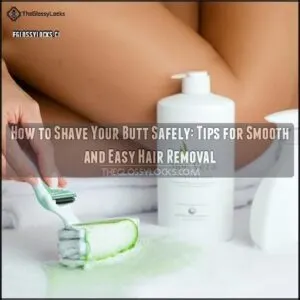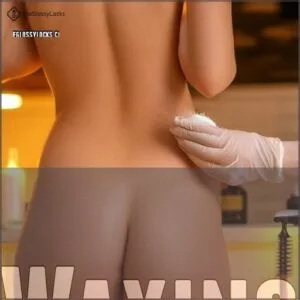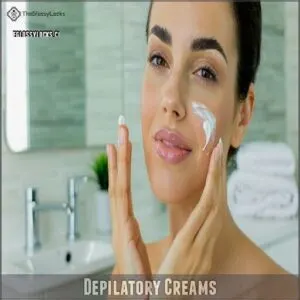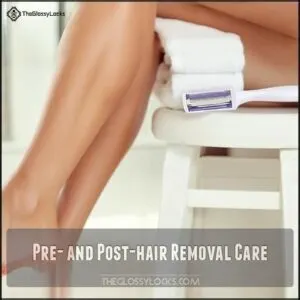This site is supported by our readers. We may earn a commission, at no cost to you, if you purchase through links.
 Shaving your butt might feel awkward, but it’s totally doable with the right steps.
Shaving your butt might feel awkward, but it’s totally doable with the right steps.
Start by trimming longer hair with scissors or a bikini trimmer. Hop in a warm shower to soften the hair and open pores.
Use a gentle, unscented shaving cream, and get into a position you’re comfortable with—standing with one leg up or squatting over a mirror works well.
Shave slowly with the grain of the hair using a fresh razor, and rinse thoroughly.
Afterward, pat dry and apply soothing aloe vera or a lightweight moisturizer. Be patient—smooth cheeks can be yours with care and precision!
Table Of Contents
- Key Takeaways
- Why Remove Butt Hair?
- Risks of Removing Butt Hair
- Temporary Hair Removal Methods
- Permanent Hair Removal Methods
- Tips for Preventing Irritation and Bumps
- When to Seek Professional Advice
- Frequently Asked Questions (FAQs)
- Do you shave your butt?
- How do you shave your buttocks?
- Should you shave a butt before using a razor?
- How to shave booty hair?
- Should I use a shaving cream on my butt cheeks?
- How do you shave a butt crack?
- Should you shave your butt hair?
- Is it normal to have hair on buttocks?
- How do you shave down there like a pro?
- Is there a hair removal cream for buttocks?
- Conclusion
Key Takeaways
- Trim the hair first with scissors or a bikini trimmer to make shaving easier and prevent razor clogging.
- Use unscented shaving cream and a fresh razor, then shave gently in the hair’s direction while keeping the skin taut.
- Rinse thoroughly after shaving, pat dry, and apply aloe vera or a lightweight moisturizer to soothe the skin.
- Avoid irritation and infection by cleaning the area before shaving, using sanitized tools, and wearing loose clothing afterward.
Why Remove Butt Hair?
Removing butt hair is mostly about personal comfort and hygiene, with some people feeling cleaner or more confident after doing it.
Feeling smooth and confident is the real win—whether you trim, shave, or wax, it’s all about what suits you best.
While it served an evolutionary purpose once, today it’s more about what makes you feel good—and maybe avoiding a few clinging toilet paper bits, which can be a matter of hygiene.
Evolutionary Purpose
Butt hair might seem like a mystery, but it’s likely an evolutionary remnant with some practical roots.
An evolutionary leftover, butt hair once helped with scent signaling and reducing chafing—nature’s anti-rash system before modern fabrics.
Back in the day, body hair, including the fuzz on your behind, may have helped with scent amplification—useful for communication among early humans.
It also played a role in chafing prevention, reducing friction during movement. Think of it as nature’s anti-rash system before spandex existed.
Hair growth in this area may have also impacted hygiene by trapping sweat and debris, keeping it away from sensitive skin. Plus, it offered a bit of insulation in colder climates.
While these purposes don’t matter much now, deciding on butt hair removal is totally up to you. Whether shaving or trimming, the choice is yours!
Personal Preference
While hair in this area once served an evolutionary purpose, today it’s all about personal choice.
Whether you’re after higher hygiene standards, smoother comfort levels, or simply following grooming tips for self-esteem or partner preferences, it’s your call.
Butt shaving can make you feel cleaner and more confident, especially if cultural norms or personal hygiene routines influence your decision.
Whatever your reason, follow shaving tips carefully—like using a mirror and keeping skin taut—to guarantee safe, irritation-free butt hair removal.
Smooth results, happy you!
Risks of Removing Butt Hair
Removing butt hair isn’t without its challenges, and it’s important to know the risks before grabbing a razor.
From razor burn to pesky ingrown hairs, a smooth finish can sometimes come with a few bumps along the way.
Razor Burn
When shaving, razor burn can sneak up on you like an uninvited guest.
It’s caused by dull blades, too much pressure, or skipping shaving gel. This irritation shows up as red, itchy patches, razor bumps, or even tiny blisters.
To prevent it, always use a sharp razor, exfoliate beforehand, and lather generously with soothing gel.
Treat razor burn with aloe vera or vitamin E oil to calm the sting. Remember, your skin’s not a battlefield—gentle strokes and proper care will keep it smooth and happy.
Razor burn, characterized by skin irritation and redness, typically appears immediately after shaving, causing red and itchy discomfort.
Rash and Itching
Dealing with skin irritation like razor bumps or itching after shaving? It’s common, but manageable.
Identifying causes, like dull razors or harsh products, is key. Opt for single-blade razors or electric trimmers to minimize razor burn.
Test creams on a small patch first to avoid allergic reactions to product ingredients. For soothing remedies, apply aloe vera or coconut oil to calm irritation.
Gently exfoliate to prevent ingrown hairs. Severe symptoms like persistent redness or folliculitis may need medical advice—don’t ignore them!
Infection and Cuts
When shaving butt hair, you’ve got to be extra cautious to avoid infection and cuts.
The skin in this area is thin and prone to nicks, making it vulnerable to bacterial infection and even fecal contamination. Start by washing the area with mild soap and warm water to reduce skin vulnerability.
Always use a fresh, sanitized razor to prevent razor burn and open wounds. Keep the process gentle—don’t rush! Moisturize before and after shaving to prevent skin irritation and create a smoother glide.
Post-shave, applying aloe vera can help soothe any redness or discomfort.
Here’s how to lower your risk of infection:
- **Use a single-use or sanitized razor for razor sanitation.
- **Wash the area thoroughly before shaving.
- **Stretch the skin taut to avoid accidental cuts.
- **Inspect for nicks and clean them immediately.
Ingrown Hairs and Folliculitis
When removing butt hair, ingrown hairs and folliculitis can sneak up like uninvited guests.
These occur when hair follicles get clogged or infected, often from shaving. To prevent this, always clean the area with warm water and mild soap before starting.
Use a sharp razor and shave in the direction of hair growth. Afterward, soothe the skin with aloe vera or a gentle moisturizer.
If bumps appear, try warm compresses or exfoliate lightly. Persistent issues? Consider professional treatments like laser hair removal for longer-term relief.
Temporary Hair Removal Methods
If you’re looking for quick and easy ways to manage butt hair, temporary methods like shaving, waxing, or using depilatory creams can do the trick.
Each option has its quirks, so let’s break them down to help you choose what works best for you (and your cheeks).
Shaving
Getting rid of butt hair doesn’t have to feel like a circus act. Start by softening the area with warm water and a shaving cream designed for sensitive skin.
A small, flexible razor is your best friend here—think precision, not brute force. Use a mirror for tricky spots and shave with short, gentle strokes in the direction of hair growth.
Keep hygiene a priority by washing with mild soap afterward. For longer-lasting smoothness, consider waxing and epilation.
To avoid razor bumps, apply aloe vera and let your skin breathe in loose clothing.
Waxing
If you’re ready to tackle butt hair removal with waxing, be prepared for smooth results and a little sting.
Hard wax works best for sensitive areas, pulling hair from the roots without damaging skin.
Follow these steps:
- Exfoliate and wash the area with warm water.
- Apply melted hard wax, then press a strip over it.
- Quickly pull the strip against hair growth.
- Soothe skin with gentle products post-waxing.
For a convenient hair removal solution, consider using a butt waxing kit.
For less pain and better results, consider professional waxing services!
Depilatory Creams
If waxing feels like medieval torture and shaving takes forever, depilatory creams might just be your new best friend.
These hair removal creams rely on chemical composition—typically thioglycolic acid—to break down keratin in your hair, letting you wipe it away like magic. Quick, painless, and no razor required!
For the best application technique, spread the cream evenly on clean, dry skin. Follow the instructions carefully—leaving it on too long can lead to burning sensations or irritation, especially if you’ve got sensitive skin. Always test on a small patch first.
Afterward, rinse thoroughly and pamper your skin with a soothing moisturizer or aloe vera. Many consumers purchase these cream products online for convenience. Cream alternatives like waxing or shaving might suit some, but for an easy, fuss-free option, depilatory creams are hard to beat!
Permanent Hair Removal Methods
If you’re tired of frequent upkeep, permanent hair removal options like laser treatments and electrolysis might be worth considering.
These methods focus on targeting hair follicles, giving you longer-lasting smoothness without the hassle of constant shaving, which leads to longer-lasting smoothness.
Laser Hair Removal
Tired of battling body hair with razors and creams? Laser hair removal could be your long-term hero. It zaps unwanted hair by targeting follicles with pinpointed laser beams, reducing regrowth over time.
Treatments are quick and effective, though it’s worth noting laser costs can add up, averaging $235 per session. Results vary depending on your hair color, thickness, and skin type, but most people need 6–10 sessions for smooth, bum-free bumps.
Follow these tips for the best outcome:
- Exfoliate beforehand to remove dead skin—think of it as clearing the stage for the laser.
- Shave within 24 hours of your session; stubble reduces effectiveness.
- Avoid UV exposure before and after.
- Hydrate with a gentle moisturizer after treatments.
Say goodbye to endless shaving!
Electrolysis
Unlike lasers, electrolysis focuses on each hair follicle, zapping it with a tiny electric current to prevent regrowth.
This FDA-approved permanent hair removal method works for all skin tones and hair types, making it super effective but time-consuming.
Sessions cost $50–$200 each, and you’ll need several since only active hairs are treated.
Yes, it’s not painless—imagine tiny pinpricks—but it’s worth it for long-term results.
One potential side effect is skin redness.
- Cost: $50–$200 per session
- Duration: Multiple sessions required
- Effectiveness: Works on all hair types
- Risks: Minor irritation
Tips for Preventing Irritation and Bumps
Nobody wants a bumpy backside after shaving, so taking steps to protect your skin is key.
With the right prep and aftercare, you’ll keep irritation and ingrown hairs from crashing the party.
Pre- and Post-hair Removal Care
Prepping your butt for shaving isn’t rocket science, but skipping steps is like inviting razor bumps to crash the party. Start by washing the area with warm water and gentle soap—think of it as a clean slate for your shaving masterpiece.
Want smoother skin? Weekly exfoliation benefits can’t be overstated. It helps remove dead skin and frees trapped hairs, making each shave smoother and less irritating.
A great way to soothe irritation is to use alcohol-free moisturizers after shaving.
Here’s a quick care guide:
| Step | Why It Matters |
|---|---|
| Clean Thoroughly | Removes bacteria, lowers infection risk. |
| Exfoliate Gently | Fights ingrown hairs and rough patches. |
| Moisturize | Keeps skin hydrated and calm. |
Before shaving, hydrate skin to soften hairs. After, wash away shaving cream and pat dry—no rubbing!
To prevent irritation, switch to loose, stretchy clothing. Infection prevention is key, so disinfect blades and check for cuts.
Butt care isn’t glamorous, but proper aftercare products like unscented lotions give that smooth finish everyone secretly loves. Who doesn’t enjoy a happy, itch-free rump?
Use of Aloe Vera
After giving your derrière the attention it deserves, it’s time for some soothing TLC.
Aloe vera is like the MVP of post-shave care, offering a cooling, calming balm for freshly shaven skin. Its soothing properties help reduce redness and irritation, making it perfect for butt care after shaving or waxing. Plus, it’s packed with antibacterial magic that can keep tiny nicks and cuts from turning into bigger problems.
Here’s how aloe vera can help you achieve that smooth butt:
- Reduces redness and inflammation, giving your skin a chance to recover.
- Moisturizes sensitive areas, keeping them soft and hydrated instead of dry and itchy.
- Helps prevent ingrown hairs, thanks to its skin-nourishing properties.
- Acts as a natural disinfectant, protecting against infection if the razor gets tricky.
If aloe’s not your thing, try aloe alternatives like witch hazel or coconut oil. Either way, your butt will thank you!
Bikini Trimmers for Shortening Hair
In the matter of taming your backside fuzz, bikini trimmers are a game-changer. These handy tools, designed specifically for sensitive areas, make body grooming safer and easier.
You’ll find trimmers with features like adjustable guard lengths, corded or cordless options, and even waterproof designs—perfect for the shower. Opt for an electric trimmer with guards to avoid irritation or cuts while trimming.
Trimming techniques matter, too. Use short, gentle strokes and keep the skin taut for a smoother finish. Unlike shaving, trimming leaves hair short rather than removing it completely, which helps reduce risks like chafing.
Afterward, maintenance is key—clean the trimmer thoroughly to prevent bacteria buildup. Consider a specialized trimmer for butt and bikini areas.
Done trimming? Treat your skin to aloe vera or a mild moisturizer; it soothes and reduces any post-trim bumps or itching. Keeping the bikini area neat has never been so fuss-free!
When to Seek Professional Advice
Sometimes, tackling butt hair removal feels like more than you bargained for, and that’s when it’s smart to call in the pros. If you’re dealing with persistent irritation, severe infections, or scarring concerns, a dermatologist can offer solutions customized to your needs.
They can also help determine method suitability if you’ve struggled with razor bumps, ingrown hairs, or contact dermatitis.
- Consult a dermatologist if irritation or infections won’t go away.
- Ask for advice when unsure which method works for your skin type.
- Check for underlying conditions causing unusual reactions.
Frequently Asked Questions (FAQs)
Do you shave your butt?
Shaving your butt isn’t a must, but if you choose to, it’s all about comfort and hygiene.
Use the right tools, go slow, and be gentle—it’s tricky terrain but totally manageable!
How do you shave your buttocks?
Think of it like mowing a tricky lawn.
Start clean, prop one leg up, lather with sensitive shaving cream, and use a small razor in small strokes.
Stretch skin taut, work carefully, and hydrate after.
Should you shave a butt before using a razor?
Trim the hair with scissors or an electric trimmer before shaving.
Long hair clogs razors and makes shaving harder.
Keep it short and manageable for a smoother, easier experience—your razor (and patience) will thank you!
How to shave booty hair?
Picture taming a jungle, not hacking at it.
Start with clean, dry skin, lather generously with shaving cream, and use a fresh razor.
Stretch your skin taut, start slow, and always shave in the hair’s direction.
Should I use a shaving cream on my butt cheeks?
Using shaving cream on your butt cheeks is a must.
It creates a slippery barrier, reduces irritation, and helps the razor glide smoothly.
Plus, nobody enjoys razor burn back there—keep things soft and irritation-free!
How do you shave a butt crack?
Did you know improper shaving causes 60% of ingrown hairs?
To shave your butt crack, lather with sensitive-skin shaving cream, use a small, flexible razor, stretch the skin taut, and shave gently with a mirror.
Should you shave your butt hair?
Shaving butt hair is totally optional.
It can boost comfort and hygiene but risks irritation or ingrown hairs.
If you’re unsure, trimming offers a middle ground.
Your grooming style should match your preferences and needs.
Is it normal to have hair on buttocks?
Life’s a hairy journey, and yes, it’s completely normal to have hair on your buttocks.
It’s a natural part of being human, helping with hygiene and reducing friction.
You’re not alone in this, and having hair is just a part of life.
How do you shave down there like a pro?
Start by trimming longer hairs, then lather up with shaving cream for sensitive skin.
Use a sharp razor, shave gently in the hair’s direction, and stretch skin taut.
Finish with moisturizer and loose underwear.
Is there a hair removal cream for buttocks?
Finding a hair removal cream for your buttocks is like searching for a gentle superhero.
Look for sensitive-skin-friendly options, test a small patch first.
Avoid using creams directly near delicate areas like the anus.
Conclusion
Mastering how to shave your butt might feel like climbing a mountain, but it’s simpler than it seems with practice.
Take your time, use the right tools, and follow each step carefully to avoid irritation or mishaps.
Keep your skin clean and hydrated with aloe vera or a lightweight moisturizer afterward.
Remember, you’re not alone—many people prefer a smoother feel back there.
With proper care, you’ll have comfortable, confident results every time.













